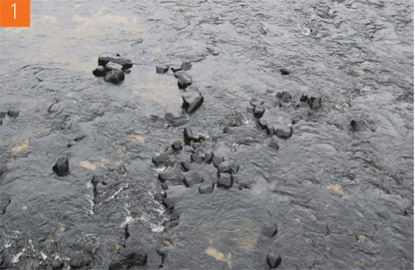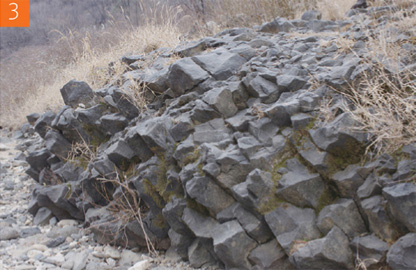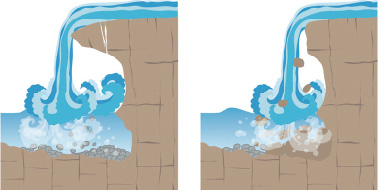Geosite
Jiktang Falls
- Cheorwon Peace Observatory
- Saemtong Spring
- Soisan Mountain (Lava Plateau)
- Jiktang Falls
- Songdaeso
- Goseokjeong
- Sambuyeon Falls
What's the difference between other falls?
Jiktang Waterfall is located on a flat basalt in the main stream of the Hantan River, unlike other waterfalls in Korea, it is widely spread along the stream's side. As water flowed over the basalt, formed with layers of lava, the basalt got chipped off along the columnar joint, due to the long-term weathering and eroding. As a result, Jiktang Waterfall is formed as a stepped formation, which is about 3 meters high, and about 80 meters wide.
The rock, which forms a direct waterfall, is a basalt made during the Quarternary Period, and is estimated to have formed between 540,000 and 120,000 years ago.
The rock is part of the basalt that forms the Cheorwon lava plateau, which flowed down and hardened along the fragile spot of the lower part of the Chugaryeong Tectonic Valley linking Seoul and Wonsan.
Things you can't see until you stop.
In the basalt exposed around the Jiktang Falls, remarkable hexagonal and polygon-shaped structures could be observed. This is the main phase of columnar joints, which develops characteristically in the basalt. The basalt lava undergoes a contraction during the cooling process, causing the surface to split into hexagonal and polygonal shapes, and as the cooling process continues, the surface gap extends to the ground. This leads to sections that look like numerous column-shaped rocks. This is where the name "Columnar joints" comes from, and erosion occurs in the areas where the columnar joints develops, causing each column to collapse and form a vertical cliff.
On the other hand, if you look around the Jiktang Falls, you can see that several layers of lava (the basalt layer) are stacked together. The lava, which repeatedly erupted from the Chugaryeong Tectonic Valley, flowed down filling the Hantan River and piled up. The lava layer of the Jiktang Falls is largely divided into two units, as the porous structure, which is often observed on the surface of the lava at the boundary of the unit, is found on Jiktang Falls lava layer too.
-
 columnar joints from the top of the waterfall
columnar joints from the top of the waterfall
-
 columnar joints from the front of the waterfall
columnar joints from the front of the waterfall
-
 columnar joints from the side of a waterfall
columnar joints from the side of a waterfall
Jiktang Waterfall: The Niagara Falls in Korea?
The nickname of Jiktang Falls is Niagara Falls in Korea. What's the connection between the two waterfalls that look similar but differ in size? If you look closely at the basalt around the waterfall, you will find the answer.
As water flows over the basalt made by various lava units for a long time, weathering and erosion effected the part of basalt to fall along the main stream, creating a stair-shaped waterfall. In this case, erosion is carried out by the falling force of the waterfall, which makes the basalt columns continue to collapse and eventually the waterfall's location gradually erodes up the river. This is the reason why it is called the Headward erosion.
Here's the answer. The Jiktang waterfall is called the Niagara of Korea because it became similar to Niagara in the process of retreating through this kind of head erosion.
 Geographical section near the Jiktang Waterfall
Part A is the contact area between the ground(granite) and the lava plateau prior to the release of lava. Part B and part D is the upper part of the lava plateau, and part C is currently the water path of the Hantan River, where Jiktang waterfall is formed.
Geographical section near the Jiktang Waterfall
Part A is the contact area between the ground(granite) and the lava plateau prior to the release of lava. Part B and part D is the upper part of the lava plateau, and part C is currently the water path of the Hantan River, where Jiktang waterfall is formed.The riverbed at the upper waterfall offers a good view of the columnar joints. [Source: Kim Joo-hwan (1997)
 The Formation Process of Jiktang Waterfall
The Formation Process of Jiktang Waterfall

